House price falls continue in most of the UK

UK house prices rose 1.11% during 2011, according to Nationwide. However in inflation-adjusted terms, UK house prices were actually down by 3.4%, following a series of annual house price drops during the past three quarters.
- In early 2009, UK’s housing house prices began to fall due to the global credit crunch. However, house prices recovered in 2010, but fell again in 2011 and continue to be weak, at least nationally:
- Nationwide says that average house prices increased by 0.1% over the year to February 2012, to £162,712 (€195,649).
- Halifax says house prices declined to February by 1.9% from a year earlier, to £160,118 (€192,530).
There was a surge of first-time buyers in January 2012, with volumes up 22% from a year ago, according to the Council of Mortgage Lenders (CML). However, this was a reaction to the soon-to-be expiration of the first-time buyer stamp duty exemption in March 24, 2012 and is expected to wear off.
A key feature of UK’s housing market is location:
- London has had positive house price growth over the past year
- the south has had slight price drops;
- the midlands and the north have experienced significant price falls.
UK house price falls are likely to continue in 2012, because of the weak economy, low consumer confidence and restricted mortgages, according to Jones Lang LaSalle. The paucity of first-time buyers has also hit transaction levels.
However the vast majority of surveyors reported only modest falls to the Royal Institution of Chartered Surveyors (RICS) Housing Market Survey of November 2011, mostly in the 0 to -2% range. The UK housing market is expected to be broadly flat in nominal terms in coming years, while house prices will be gradually eroded by inflation.
No interest rate hike
Expectations for a rise in the Bank of England’s (BoE) base rate to 0.75% did not materialize, as the BoE decided to keep its record low base rate of 0.5%, in place since July 2011, despite an inflation rate twice the 2% target till December 2011. The low rate will probably remain unchanged until August 2012 according to British Chamber of Commerce (BCC) Chief Economist David Kern. Moreover, an increase of benchmark rate to 1% is expected in Q4 2012 and to 2.25% by end of 2013. Even though the headline CPI remains above the target of 2%, it is a rather improvement from 2011’s average rate of 4.48%.
At the beginning of 2012, the BoE implemented a further £50 billion (€60.12 billion) of quantitative easing. The UK suffers from high unemployment, which rose to 8.4% of the working population, to 2.67 million, according to January’s Office for National Statistics (ONS) report. Economic activity only grew by a 0.8% during 2011, a decline from 2.1% growth in 2010.
The UK’s credit ratings are on the verge of being downgraded from AAA by Moody’s and Fitch. Both have a negative outlook for the UK, warning that the UK should stabilize its public debt at around 94% of GDP by 2014-2015. By the end of January 2012, if financial interventions are included, UK public debt was around 147.3% of GDP.
From boom to doom
In UK property prices peaked in Q3 2007, after huge rises from 1996-2007:
- Prices in Northern Ireland rose by 458.6% from Q3 1996 to Q3 2007 (361% in real terms), the highest rise among all the UK regions
- Prices in London rose 310% (238% in real terms) during this period.
- Price increases in other regions during this period ranged from 194.5% (143% in real terms) for Scotland, to 266% (202% real) for the Outer South East.
- The national index rose 259% (196% in real terms) over the same period (all figures from Nationwide).
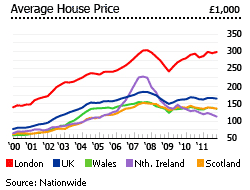
In early 2007 interest rates were raised, and lending conditions tightened. House price falls accelerated in H2-2008, due to the global financial meltdown and the economic recession. The collapse of Iceland’s banking system led to substantial losses for around 250,000 British depositors, exacerbating the situation. The regions that experienced the highest price rises during the boom, generally had the biggest price falls from Q3 2007 to Q1 2009.
The biggest drop occurred in Northern Ireland where house prices fell by 39.8% (-42% real) during the year to Q1 2009. House price falls in other regions ranged from 14.1% (-17.85 real) for Scotland, and 25% (-21.7 real) in East Anglia. London house prices dropped by 19.8% (-23% in real terms).
In Q4 2011, the average London house price was 1.08% up on the previous quarter (0.08% in real terms):
- House prices averaged £247,058 (€297,069) in Outer Metropolitan London, and £198,363 (€238,517) in the Outer South East.
- Northern Ireland has the cheapest average house prices at £113,614 (€136,612).
- East Midlands, Yorkshire & Humberside, North West, Wales and Scotland have relatively cheap house prices, at around £134,000 to £140,000 price range.
Historic low key rate remains unchanged
The Bank of England’s (BoE) key rate has remained unchanged at 0.5% for the past three years. It is the lowest rate in the BoE’s history. The rate is forecast to remain unchanged up to 2015, according to Vicky Redwood, chief UK economist at Capital Economics. Redwood also believes there is the possibility of a bank rate cut to 0.25%.
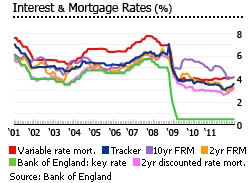
From 2002 to 2006, the key rate fluctuated from 3.5% to 5%. In 2007, it was raised three 25 basis point steps, leading to a rate of 5.75% in July. Then came the crisis, and in November 2008 the BoE had the biggest rate cut in its modern history, with the key rate slashed 1.5 percentage points to 3%.
Mortgage interest rates have not tracked the BoE’s key interest rate down fully. Interest rates on housing loans were between 5.5% and 6.5% between 2007 and 2008, which the exception of standard variable-rate (SVR) mortgages. Mortgage interest rates then started to inch downward in mid-2008, but the spread between the key rate, and the average mortgage rate, has widened to around 3 – 5 percentage points, from less than one percent in 2006 - 2008.
In January 2012, average interest rates for types of mortgages with 75% loan to value (LTV) were:
- 3.27% for 2-year fixed rate mortgages (FRMs)
- 3.77% for 3-year FRMs
- 4.18% for 5-year FRMs
- 3.19% for discounted rate mortgages
- 3.57% for tracker mortgages
- 4.16% for SVR mortgages
Mortgage market nearing recovery
During the financial crisis many lenders lowered LTV ratios, according to the Council of Mortgage Lenders (CML). By Q3 2010 the average LTV ratio was 77%, with the result that the average new buyer was paying 94% of his income as deposit on his house purchase.
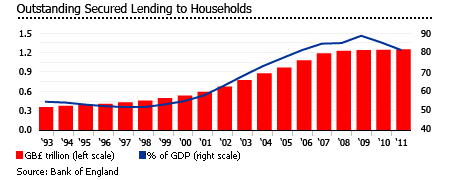
This was in dramatic contrast to the boom era, when UK banks commonly extended 90% LTV ratio loans to first-time buyers. In Q1 2007, the average buyer was paying only 37% of income as a deposit.
Tighter lending conditions and declining demand for prime lending is reflected by the outstanding lending’s meagre growth of 0.5% in 2011. Mortgage lending declined to 81% of GDP, from 85% in 2010. In contrast, between 2001 and 2007 outstanding secured lending volumes had risen by more than 10% annually, from 55% of GDP in 2000, to 85% of GDP in 2007.
There was a welcome rise in secured lending at high LTV ratios in 2011. Lenders expect a further slight increase in the availability of secured credit to households in Q1 2012, especially for high LTV ratio borrowers, according to the BoE’s January 2012 “Trends in Lending”.

Although down by 14% from £12.2 billion (€14.7 billion) in December, mortgage lending in January 2012 was, at £10.5 billion (€12.6 billion), a 10% increase from January 2011’s £9.5 billion (€11.4 billion) total.
This was the 6th month in a row of higher y-o-y lending volumes, according to the CML, but it may be due to temporary factors. It was announced in November 2011 that the stamp duty concession will end on March 24, 2012. The concession exempted first-time buyers from stamp duty on properties up to £250,000 (€300,607).
A“NewBuy scheme” was introduced in March 2012 whereby Barclays, NatWest Home Loans Ltd and Nationwide Building Society offer mortgages of up to 95%, with government support for 100,000 NewBuy properties over three years.
NewBuy operates through cash contributions from builders into a fund to offset the lender’s loss if a borrower defaults and the property can’t be sold above its mortgage value.
Low rental yields
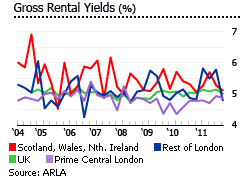
The South West has the UK’s high rental yields at 5.24%, followed by the North West (5.13%) and the combined area of Scotland, Wales and Northern Ireland (5.12%). Prime Central London and has lower yields at 4.88%, and the “Rest of London” has yields of 4.81%. The Midlands does relatively poorly too, at 4.98%. Rental yields in UK fell slightly in the last quarter to 5.02%, from 5.15% in Q3 2011, according to the Association of Residential Letting Agents (ARLA).
Despite strong rental demand, rental growth is moderating, after rather sharp growth during early-2011 because of rising new residential lettings supply.
Rent increases are still occurring in the South East, while rents in London, the South West and the North have stabilized. Nationally, the rental outlook revealed ARLA’s survey is positive (meaning more surveyors believe that rents will increase), but London and the East recently had the first negative net balance since July 2009.
Gross rental yields on flats in Prime Central London range from 4.31% to 4.86%, according to the June 2011 Global Property Guide rental yields survey, with smaller units earning the highest returns. For other luxurious areas in London, gross yields range from 4.10% to 5.54%.
Low housebuilding activity
The UK’s per capita housebuilding rate falls short of international standards, and failed to respond to booming house prices during the boom, due to building regulations and planning constraints. The situation improved during the later years of the boom, but output declined again during the recession. Ironically, this has prevented the housing market suffering a large overhang of properties, a fate shared both by Ireland and Spain.
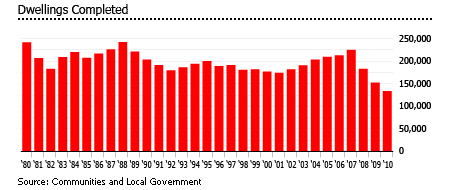
Increases in population, immigration, and changes in household sizes have all added to the pressure. Despite rapid rise in house prices between 1996 and 2002, housebuilding actually fell during this period. The amount of available land for housebuilding, and the long processing time for development permits, both discourage new building.
A reform of the planning system, relying on local initiatives, is under way to speed the system up and expand the housing supply. Extra funding for local government, depending on the number of new local home units built, is available.
However, the government’s budget constraints are putting all this under threat.
The government is targeting around 240,000 new dwellings annually until 2020. However, the target seems possibly unrealistic, since output over the past 20 years has been around 150,000 dwellings annually. RICS therefore suggests that the long-term outlook inevitably involves severe housing shortages and increasing house prices.
In a discussion paper published in September 2009 by the Town and Country Planning Association (TCPA), researchers warned that at least 250,000 new homes must be built annually to match population growth, to replace the ageing housing stock and the accumulated backlog. Their analysis suggests that the housing deficit may reach one million by the end of 2010.
Homebuilding stagnated at an average of 186,000 new units annually between 1991 and 2003, and from 2004 onwards barely exceeded 200,000 annually (222,490 in 2007). In 2008, the credit crunch combined with falling house prices reduced house building, and less than 100,000 completions took place in 2009.
Housebuilding in the UK today is still only just above half pre-crisis levels.
Heading towards recession?
UK’s economy possibly faces a double-dip recession this year. GDP grew by a measly 0.8% in 2011, a sharp decline from 2010’s 2.1% growth. But industry surveys in recent months have been encouraging, so economists are still unsure if UK’s economy is deteriorating.
Opinion on the issue is divided:
- The British Chamber of Commerce (BCC) believes that the UK can avoid the recession
- The OECD and Standard Chartered think that Britain will face a double-dip recession. The OECD expects a slump in the first two quarters of 2012, and growth of just 0.5% for the full year.
The possibility of a recession seems to be getting stronger, as in the last quarter of 2011 GDP fell by 0.2% q-o-q.
Last year’s GDP fall was largely caused by a major decline in business investment, as well as a 1.4% decline in production.
Unemployment was about 8.4% in January 2012, the highest number of unemployed since 1994, according to the Office for National Statistics.
In January 2012, the BoE Consumer Price Index rose 3.6%, far above the central bank’s 2% target. BoE governor Mervyn King expects inflation to fall continuously from now on, as the impact of the 2011 VAT increase wears off, and smaller increases in the cost of commodities and oil kick in.
PARTNER INFORMATION
If you´ve had an offer accepted and are looking for a mortgage then look no further than The Mortgage Broker, they´ll find the best mortgage for you.
House prices may be falling but some people still can´t afford to buy their own and need to find houses to rent